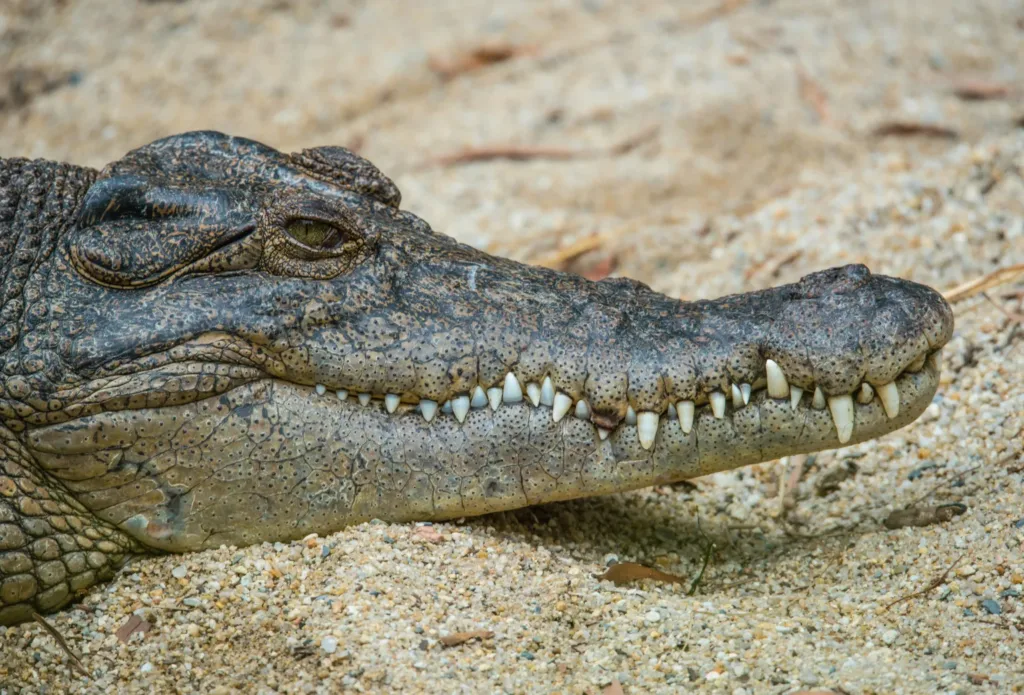Why in the news?
- The State Forest Department released a census regarding the Saltwater crocodile. If we compare it to the last year, it shows that the number of saltwater crocodiles in the Sundarban Biosphere Reserve (SBR) has increased. These crocodiles are among the largest reptiles in the world.
- Due to human activities, saltwater crocodiles (Crocodylus porosus), which were formerly found in southern China and Vietnam, have gone extinct in these regions.

Saltwater Crocodile: Key Facts
The saltwater crocodile, also known as Crocodylus porosus. It is the largest and heaviest living reptile on the planet. Below are some of the saltwater crocodile facts:
- Saltwater crocodile is also known as the “sea crocodile”, “marine crocodile”, “Indo-Pacific crocodile”, and “estuary crocodile”. It is more informally addressed as “saltie”.
- It is an apex predator that is hypercarnivorous and opportunistic in nature.
- Saltwater crocodile is an important reptile for the ecosystem.
- Distribution: From the east coast of India through Southeast Asia, the Sundaic area, northern Australia, and Micronesia.
- The saltwater crocodile primarily lives in brackish marshes and saltwater habitats.
1. What are the Features of a Saltwater Crocodile?
- The size of a saltwater crocodile differs in accordance with their gender:
- An average female saltwater crocodile measures slightly less than 3 m in length and weighs less than 100 kg.
- An average male saltwater crocodile is typically 5m long or more. They may weigh around 500 kg.
- Females typically become sexually mature at around age 10–12. It is approximately five years earlier than males.
- Although the colouring of the saltwater crocodile varies, they usually have paler underbellies and a dark, greenish-brown colouration that helps them blend in with their watery environment.
- They are shielded from possible dangers by their thick, robust scale-armored skin.
- They are solitary animals, particularly in the case of adult males.
- The saltwater crocodiles are highly territorial. Large male saltwater crocodiles frequently control vast tracts of rivers, estuaries, or beaches.
2. What is the Habitat of a Saltwater Crocodile?
The saltwater crocodile habitat covers a large area of Asia:
- The saltwater crocodile can be found in three places in India: the Andaman and Nicobar Islands, Bhitarkanika National Park, and the Sundarbans. These three are the primary saltwater crocodile habitat in India.
- Together with the gharial (Gavialis gangeticus) and mugger crocodile (Crocodylus palustris), it is one of the three crocodiles indigenous to the Indian Subcontinent.
- Additionally, it can be found in the Solomon Islands, Australia, Papua New Guinea, Brunei, Bangladesh, Malaysia, and Indonesia.
- The species’ range in antiquity stretched from southeast China, Palau, and Vanuatu in the east to the Seychelles and Kerala, India, in the west.
3. What are the Threats to the Saltwater Crocodile?
Below are some of the threats to the saltwater crocodile:
- Destroying, transforming, and fragmenting the habitats of saltwater crocodiles.
- Fishing activities and using crocodile parts for medical uses.
What is the Conservation Status of the Saltwater Crocodile?
The IUCN has declared the saltwater crocodile as “least concern” in the IUCN list of Threatened Species.
- IUCN List of Threatened Species: Least Concern
- CITES: Appendix I (except the populations of Australia, Indonesia and Papua New Guinea, which are included in Appendix II).
- Wildlife Protection Act, 1972: Schedule I
Conclusion
In conclusion, the saltwater crocodile is a remarkable apex predator that plays an important role in its ecosystem. With an average length of over 3 meters, these reptiles thrive in a wide range of diverse habitats. The saltwater crocodile’s habitat primarily includes regions such as the Sundarbans and the Andaman Islands.
Though they are currently listed as “least concern” by the IUCN, their populations face risks from habitat destruction and hunting. It is important to continue conservation efforts to protect this species and the fragile ecosystems it lives in.
For more wildlife information, explore WWF and International Big Cat Alliance.
Frequently Asked Questions
Saltwater Crocodile
An opportunistic hypercarnivorous apex predator.
Least Concern.
Dark greenish-brown on top with lighter underbellies, helping them blend with water environments.









